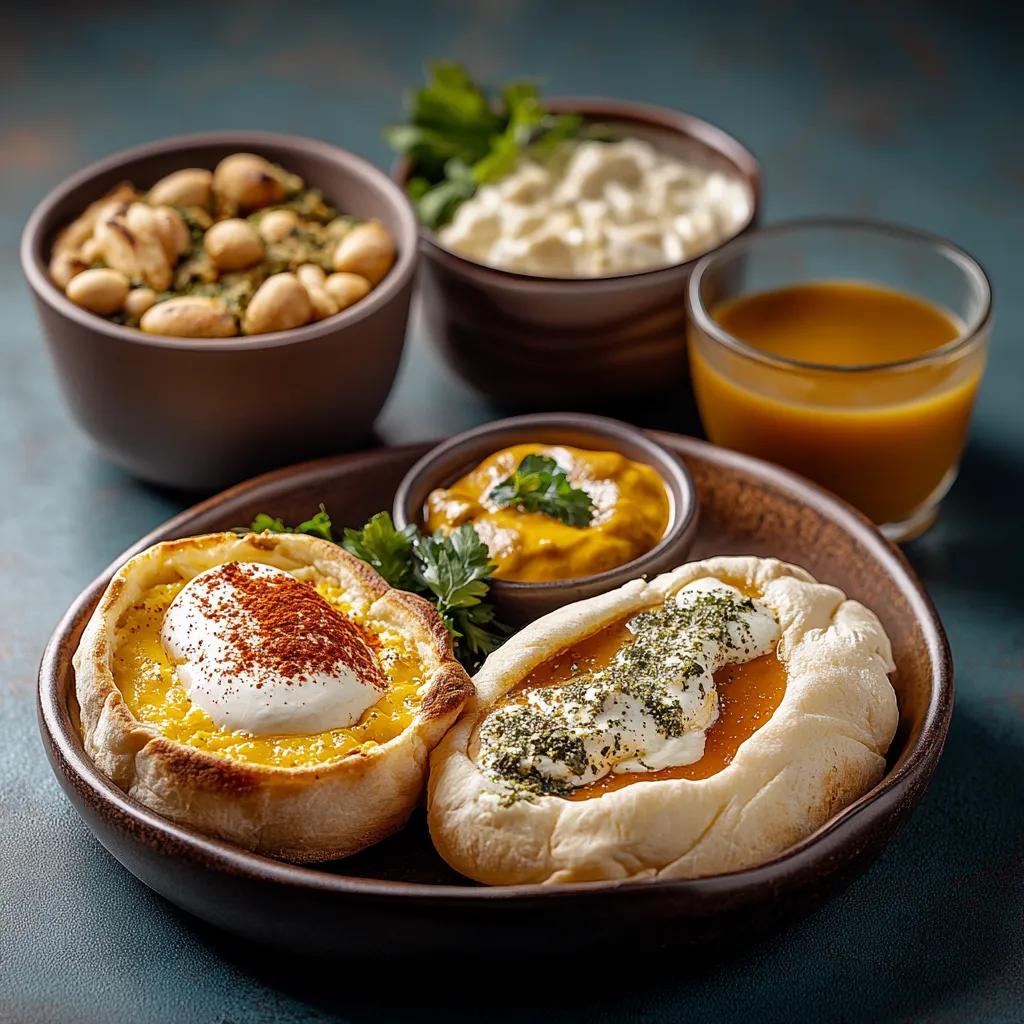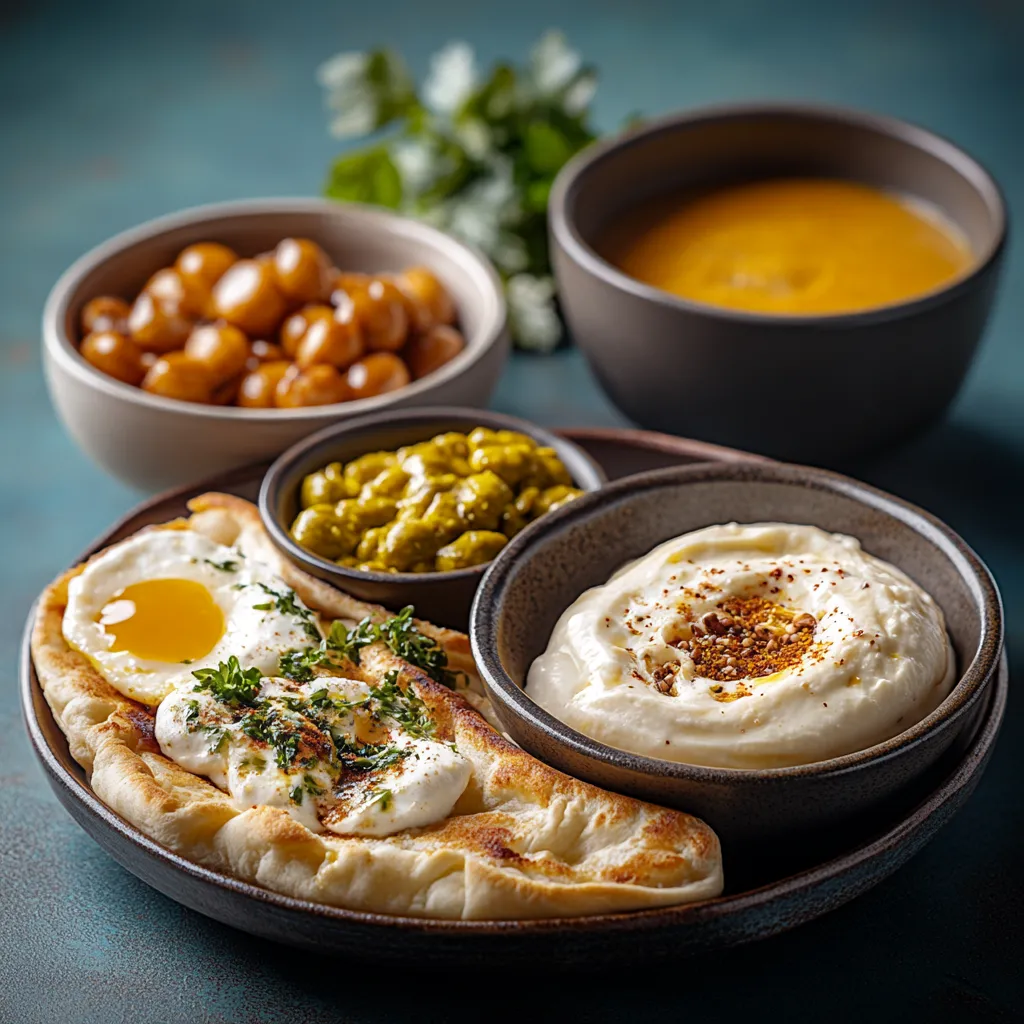 Save
Save
A well-made Saudi breakfast platter brings instant comfort to the table, with its inviting mix of savory spreads, warm bread, and herby flavors. This spread is all about sharing and slow mornings, featuring labneh dusted with zaatar, creamy hummus, tender foul mudammas stewed with garlic, and soft scrambled eggs. Every bite feels familiar and filling, just like the laid-back breakfasts I enjoyed with family in Riyadh where the air always smelled like brewed black tea and warm bread edges.
My first time preparing this platter I was missing home and these flavors made my new apartment feel warm and welcoming. Now even my friends abroad ask for this spread when they visit for weekend brunch.
Ingredients
- Plain Arabic bread: Khubz is soft and perfect for scooping use freshly baked or buy from a Middle Eastern bakery
- Creamy labneh: Smooth strained yogurt cheese adds tang and creaminess choose thick labneh for the best texture
- Za’atar: Adds herbal brightness look for a green mix with sumac and sesame seeds for freshness
- Olive oil: For drizzling and richness pick extra virgin for flavor
- Fava beans: Canned fava beans save time and still taste hearty go for ones with no added salt if possible
- Garlic: Fresh cloves give big flavor select firm and unblemished bulbs
- Cumin: Brings warmth and gentle spice ground fresh cumin makes a difference
- Lemon juice: Lifts all the flavors use freshly squeezed for zing
- Hummus: Chickpeas and tahini blend into a creamy base canned chickpeas are just fine as long as you rinse them well
- Tahini: Adds nutty depth look for a smooth light sesame paste with no bitterness
- Butter: For scrambled eggs unsalted gives you control over seasoning
- Eggs: Use fresh eggs for fluffier texture and better color
- Salt: Choose sea salt or kosher salt for seasoning
- Black tea: Bold and aromatic brew in a glass for classic Saudi style
Step-by-Step Instructions
- Prepare the Foul Mudammas:
- Mashing fava beans creates a creamy rustic texture that holds seasonings well. Gently warm beans with olive oil lemon juice minced garlic salt and cumin in a saucepan. Stir often over low heat to blend flavors and prevent sticking. Taste and adjust salt before moving to a bowl.
- Blend the Hummus:
- Blending rinsed chickpeas tahini garlic lemon juice and salt in a food processor makes a creamy centerpiece. Scrape down the sides midway to ensure every bit is smooth. Spread in a bowl smoothing the surface then finish with a generous olive oil drizzle.
- Scramble the Eggs:
- Whisk eggs lightly with a pinch of salt just until combined. In a nonstick pan melt butter over low to medium heat then pour in eggs. Stir gently and frequently with a spatula keeping the eggs moving until just set but still soft and glossy. Remove from heat promptly to keep them tender.
- Assemble Labneh with Zaatar:
- Spoon a thick round of labneh into a small dish. Sprinkle a layer of zaatar evenly across the top and add a swirl of extra virgin olive oil. The aim is a bright green cap of herbs with golden oil pooling around the edges.
- Warm Bread and Brew Tea:
- Wrap Arabic bread in a clean towel and warm in a dry skillet or low oven so it stays soft. Fold or cut before placing beside the platter. Brew strong black tea and serve in glass cups for the authentic touch.
 Save
Save
I always look forward to labneh with zaatar because its herby tang instantly brings back memories of bustling family breakfasts where everyone dive in with warm bread and no plate is ever empty for long. My younger siblings still argue over who finishes the last bite of hummus.
Storage Tips
Leftover hummus and foul mudammas last well for up to three days in sealed containers in the fridge. Labneh can last a week and even tastes more flavorful after a day. Scrambled eggs are best eaten fresh but you can prepare all spreads ahead and rewarm gently before serving. Bread can be kept wrapped at room temperature for a day or frozen for longer storage.
Ingredient Substitutions
If you do not have labneh use Greek yogurt strained overnight in a cloth for a similar texture. No zaatar Swap for dried oregano and a little sumac if available. White beans can replace fava beans for the foul. For vegan needs skip eggs and try avocado slices with a sprinkle of lemon and cumin.
Serving Suggestions
Build the platter with little bowls for each dip and spread so everyone digs in from the middle. Add extras like cucumber and tomato wedges a few olives and radishes for crunch. Some families finish breakfast with a drizzle of honey on bread alongside their tea.
Cultural Context
A Saudi breakfast platter reflects the country’s tradition of hospitality and leisurely morning meals. It encourages lingering conversation and shared laughter with every bite. Each spread tells part of the story from tangy yogurt traditions to the Ottoman influence in foul mudammas and vibrant market spices in zaatar.
Recipe FAQs
- → What is labneh and how is it served?
Labneh is a creamy strained yogurt cheese. It is served with a sprinkle of za’atar and a drizzle of olive oil for flavor.
- → How do you prepare classic foul mudammas?
Foul mudammas is made by mashing fava beans and simmering them with olive oil, lemon juice, garlic, salt, and cumin.
- → What makes hummus smooth and flavorful?
Blending chickpeas with tahini, garlic, lemon juice, and salt ensures a smooth, creamy texture and balanced taste.
- → How are traditional scrambled eggs made for this platter?
Eggs are whisked with salt, then slowly cooked in butter, stirring gently until they’re just set and soft.
- → Why is tea important in a Saudi breakfast?
Robust black tea accompanies the platter, helping balance the savory flavors and offering a warming start to the morning.
- → What type of bread pairs best?
Warm, soft Arabic bread like khubz is ideal for scooping up labneh, hummus, and foul, tying the meal together.
